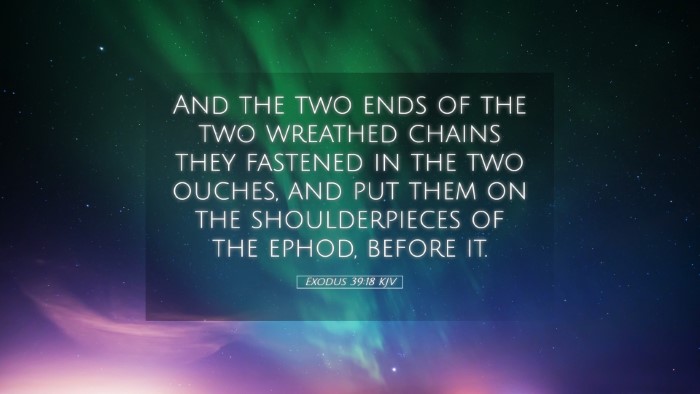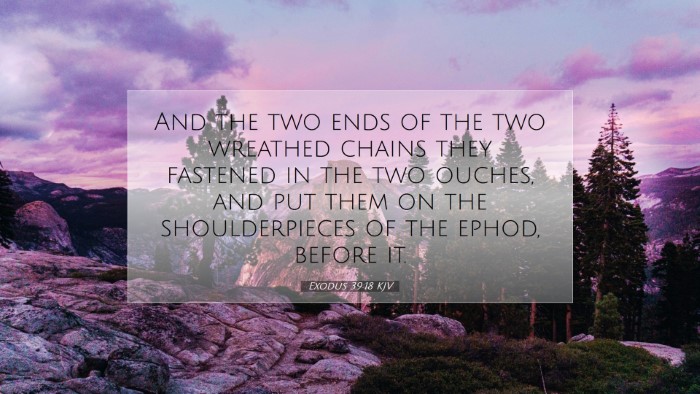Exodus 39:18 Commentary
Verse: "And the other end of the ephod, which was upon the back part thereof, was joined to the breastplate." (Exodus 39:18)
Introduction
The significance of the garments worn by the high priests, particularly the ephod and breastplate, is a focal point in the study of the priestly order established in the Old Testament. In Exodus 39:18, we see the ephod—the outer garment—paired with the breastplate, which bore the Urim and Thummim. This particular verse encapsulates themes of divine revelation, the mediatorial role of the priest, and the majestic design ordained by God.
Historical Context
This verse occurs within the broader narrative of the construction of the Tabernacle, where specific instructions for priestly garments were meticulously outlined by God through Moses. Understanding these garments' creation and purpose helps illuminate their significance in ancient Israelite worship.
Symbolism of the Ephod and Breastplate
- The Ephod: Represents strength and service. It was designed to carry the responsibilities of priesthood and signify the presence of God among His people.
- The Breastplate: Symbolizes judgment and divine will. It held the Urim and Thummim, which were used for decision-making and revelation from God.
Theological Insights
Meditations from Matthew Henry
According to Matthew Henry, the joining of the ephod and breastplate underscores the connection between the priest’s duty to bear the burdens of Israel and to seek God’s guidance on their behalf. The high priest's attire served not just as ceremonial clothing but as a representation of intercession, illustrating the closeness between God and His people.
Reflections from Albert Barnes
Albert Barnes notes that this verse highlights the intended harmony and unity within the priestly garments. The phrase “was joined” signifies that the functions of mediation (breastplate) and service (ephod) are inseparable. He suggests that this represents how divinely appointed leaders are to function with a balance of authority and humility, always seeking guidance from the Lord in their endeavors.
Insights from Adam Clarke
Adam Clarke elaborates on the construction details of the ephod and its importance in the temple service. He emphasizes that the physical joining of the breastplate to the ephod demonstrates a foundational truth in the relationship between God and the Covenant people. Clarke interprets this joining as a foreshadowing of the New Testament fulfillment in Christ—the ultimate High Priest who connects the earthly and heavenly realms.
Practical Applications
For pastors, theologians, and students of the Scriptures, Exodus 39:18 offers numerous applications:
- In Ministry: The intertwining of roles and responsibilities in spiritual leadership requires a commitment to prayer and dependence on God.
- In Discipleship: As believers, we are called to carry the burdens of one another, much like the high priest bore the names of the tribes on his breast.
- In Worship: The importance of recognizing God’s presence in our midst as we worship reflects the original intent of the Tabernacle's purpose.
Conclusion
Exodus 39:18 serves as a powerful reminder of the significant roles played by the high priest in the Old Testament and how these roles prefigure the ministry of Jesus Christ. It calls us to reflect on our own lives, considering how we bear witness to God's presence and truth in our communities today. The visual imagery of the joined ephod and breastplate encapsulates the heart of God’s desire for relationship with His people, urging us to approach Him with reverence and faithfulness.


